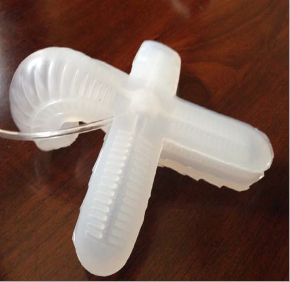Testing
This section will outline the testing of the prototype done by us. The accuracy of the sensors will be shown, along with how the soft robot gripper compares with that of the human hand. An analysis will be conducted on the linearity/consistency of the soft robot gripper vs the human hand vs the sensor alone, which will serve as the control group. This analysis will happen in three major senses used in gripping: flex, temperature, and pressure. This will show how well the gripper will work with a patient with neuropathy.
 |
For these tests, there are 3 steps:
- Evaluate linearity of sensors individually
- Temperature sensor between 12 - 42 degrees C - sensitivity between .05 to .2 degress
- Pressure Sensor up to 25 psi
- Flex angle 180 degrees with accuracy to 1 degree
- Create a working model
- Add sensors to microprocessor to build prototype circuit
- Test soft robot in environment and changes in parameters
- Evaluate Data
- Compare soft robot data to that of human hand
Next steps:
- Develop prototype with wireless sensors
- Evaluate Communication Connectivity - make an app or way for feedback for the user
- Keep developing prototype so that it is more consistent to make and use
Flex Sensor

The graph above shows the linearity of the flex sensor in a normal circuit with a servo motor. In this circuit, the sensor is alone, showing that it works properly and can be used in the gripper.

This graph shows flex position over time, with the blue line being for no manipulation (control), the red line being for the contours of the gripper, and the yellow line being for the contours of the human hand. Without manipulation, the flex resistance does not change at all, which is expected. The gripper and hand both fluctuate wildly, but they both cover the same range. This means that the gripper can "flex" to any position the human hand will normally, showing that the flex sensor will work properly with the gripper for patients with neuropathy.
Temperature Sensor

The graph above shows the linearity of the temperature sensor, showing that it can be used in the soft robotic gripper with accuracy.

This graph shows the temperature profiles of room temperature, the gripper, and the human hand over time. The blue line is for room temperature, the red line is for the soft robotic gripper, and the yellow line is for the human hand. The room temperature stays within 1 degree, which is not unusual. The gripper and hand have temperatures about 3 degrees away from one another, but this is not enough to make a significant impact on the results of temperature sensing in the gripper. Overall, there is no convincing evidence to suggest that the temperature sensor will not work in this soft robotic gripper.
Pressure Sensor

This graph comes from the Tekscan website, where I got the pressure sensor. The one I am using corresponds to the red 25lb force range line, which is relatively linear. This shows that the pressure sensor can be used in the soft robotic gripper.


This graph shows the pressure of the gripper and the human hand over time. The left graph is for the soft robot gripper, while the right graph is for the hand pressure. Both were measured when pressing as hard as possible, which is not necessarily needed to hold an object. The soft robot's pressure only went up to .75 psi at the most, which is barely enough to hold something, but the gripper should be fine to hold things depending on the air source. A weak air source may produce too little pressure, while a strong one may produce too much. The hardest hand pressure is about 2.75 psi, which is definitely enough to hold something, but harm something fragile. Although these pressures are very different, they should not affect the overall function of the gripper too much, therefore showing that the gripper will work properly in the aspect of pressure.